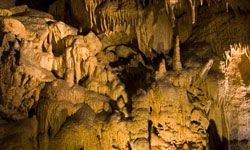While most of us like to think we're standing on solid ground, the reality is quite the contrary: The Earth just beneath our feet is kind of like Swiss cheese. It's riddled with holes, networks of them, carved into layers of stone by dripping water or eaten away by acid over millions of years. And when those holes have an opening at the surface of the Earth and are big enough for a human to climb into, they're called caves.
The most common caves are limestone caves. They've been eroded by mildly acidic water flow, often from rain or melting snow. Water becomes acidic when it mixes with carbon dioxide in the atmosphere. Limestone erodes easily, and there are tremendous networks of winding caverns underground in areas with limestone landscapes (a geological feature called karst). More rarely, caves result from intense occurrences like volcanic activity or the release of sulfuric acid from underground sulfur deposits.
Advertisement
However they're formed, caves can be incredible sights. Most have been slowly decorated over unimaginable time frames by the water that carved them out.
As temperature changes cause minerals to come out of solution, stalactites grow downward from the roof and stalagmites grow upward from the floor. The two meet in the middle to form columns. Minerals collect on walls, creating massive, textured murals, and water features dot the underground landscape. Sometimes, entire rivers run underground.
In this article, we'll take a look at five of the most amazing caves out there. Each contains incredible features that make them noteworthy, and most of them are open to the public -- even to the nonspelunking public.
First on the list is one of the most popular caves in the United States, drawing millions of visitors every year. And for good reason.





